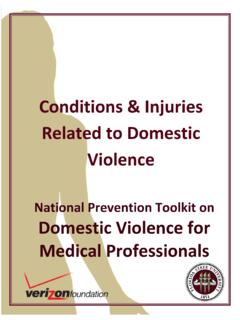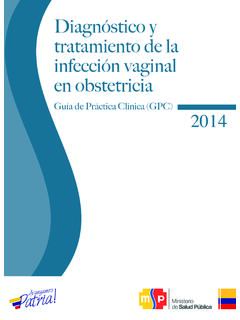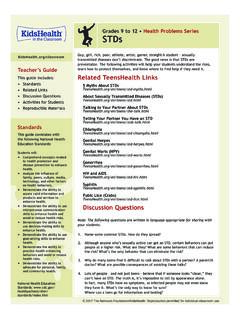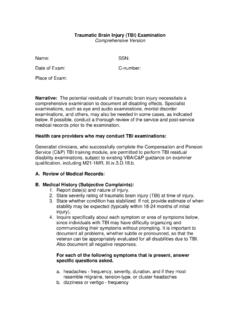Transcription of NEWBORN DISCHARGE INSTRUCTIONS
1 NEWBORN DISCHARGE INSTRUCTIONS . Congratulations on your new baby! We hope your coming weeks are wonderful and that you have a smooth transition into caring for your baby at home. This handout is meant to be a quick snapshot of the things that seem to be on every parent's mind as they prepare to leave the hospital with their new baby. This is by no means a comprehensive list of issues relating to NEWBORN care, but will hopefully be a good place to start. Recommendations about NEWBORN care change from time to time and we hope the information in this handout is helpful. Breast feeding: Breast-fed newborns often nurse every 1-3 hours at first. Nurse from each breast at first, alternating the side on which you begin. Introduce as much of the nipple and areola (dark area around the nipple) into your baby's mouth as possible to promote proper latching.
2 Suckling stimulates both milk production and the let down of milk the more you nurse, the more milk you will produce and the faster it will come in. A mother's breast milk begins as thin, watery milk called colostrum this provides substances that help your baby fight infections, and is a proper blend of nutrients for the NEWBORN 's stomach. Within a few days, your milk will come in and breast feeding will be more filling for your NEWBORN . Most babies do not need to supplement with formula during these days, but we may recommend supplementing in certain circumstances. The most important marker that feedings are going well is good growth. Breast-fed babies can lose up to 10% of their birth weight during the first week of life, but should regain their birth weight during the second week of life.
3 Breast-fed babies should be seen by their pediatrician at 1 week of age for a weight check. If you intend to breast feed, do not give up during the first few weeks these are the hardest times, and things will get easier. Discuss problems with your pediatrician, your lactation consultant, or friends and family who have experience breast-feeding. Remember, your baby eats what you eat. Some babies are sensitive to caffeine, broccoli, tomato sauces, spicy foods, cabbage, beans, cow's milk products, etc . Formula feeding: Your baby should feed every 2-3 hours at first, but may be able to go 3-4 hours between feeds within a few weeks of life. Typically newborns take -2 ounces per feeding at birth, and can often take 2-3 ounces per feeding within a few weeks of life.
4 Some babies take more and some take less. Adequate weight gain is the best indicator of effective feeding, so we will be monitoring weight closely during well visits. Your baby will let you know they are ready for more milk by crying, acting fretful, rooting or chewing on fists but sometimes babies overeat and begin spitting up. Avoid the urge to change formula without discussing it with your pediatrician. It is normal for your baby to have gas, a variety of stool changes, and mild intermittent spit-ups. Do not warm formula in the microwave. Always swirl the formula around after warming it and check its temperature on your wrist before giving it to your baby. Do not bottle prop! . Give nothing but formula or breast milk for the first 4 months of life. You do not need to give additional water.
5 Do not give regular milk (whole milk, skim milk or 2% milk) or evaporated or condensed milk. Vitamins: It is recommended that all infants receive 400 IU vitamin D once daily. A daily vitamin supplement is recommended, especially for exclusively breastfed infants. 1. Spit ups & vomiting: It is common for newborns to occasionally spit up small amounts of milk. If your baby spits up more than usual, or has projectile vomiting discuss this with us. Choking, gagging and turning blue after spitting up is also abnormal and should be discussed with us immediately. You should be comfortable using the bulb suction syringe before you go home from the hospital it is used to help clear the mouth, throat and nose of secretions or vomit. Burping: Babies should be gently burped after feedings, and occasionally during feedings.
6 If your baby is spitting up whenever you burp him, consider not burping him any longer or changing the way you burp him. Avoid pressure on the belly or laying your baby flat after feedings. Urine and poops: Your baby should have at least 5-6 wet diapers in 24 hours. Let us know if the urine output is less or substantially more. NEWBORN stools can take a variety of colors, textures, odors, and amounts. The first few stools are often dark black, tarry and sticky these are called meconium. Typically breast-fed babies have loose, yellow, seedy stools with almost every feeding. Formula fed babies often have transitional stools: episodes of frequent, loose stools alternating with episodes of less frequent, more formed stools. The normal stool frequency for newborns varies from once with every feeding to once every other day.
7 Many moms worry about their baby's stools because it seems like bowel movements hurt them but there is no reason to think that bowel movements hurt babies any more than they hurt adults. Some babies have difficulty coordinating their bowel movements they squeeze their bottom closed while they push instead of relaxing their bottom. Gentle rectal stimulation with a thermometer, or Q-tip, with petroleum jelly can often help them relax their bottom and assist them with their bowel movement. Avoid suppositories or formula additives unless recommended by us. Hard balls of stool, blood in the stool, and mucus diarrhea are abnormal and should be discussed with your doctor. Skin color: Your baby's hands and feet may occasionally turn purple and cool to touch, with mottling of the skin on the arms and legs.
8 This does not necessarily mean your baby is cold. This will likely go away after a few days or weeks of life. If your NEWBORN turns blue on the chest or around the nose and mouth it is an emergency you need to call 911 and come to the ER. Jaundice: If your baby's skin and eyes begin to look yellow, the baby could have jaundice. This typically is the worst on the third day of life, and therefore might not be noticed before the baby is discharged from the nursery. Discuss this with your baby's pediatrician immediately. Fever: Fevers are medical emergencies in newborns. The definition of fever is F or greater. [Low temperatures (below 97 F) are also urgent.] The correct way to check for fever is by rectal thermometer the number you see is the actual temperature.
9 You may consider using under-arm temperatures but you need to add 1 degree to it to estimate the rectal temperature. If the under-arm temperature is abnormal, always confirm it with a rectal temperature. Umbilical cord: Clean the umbilical cord periodically with alcohol and a cotton ball. The cord itself has no sensation and you will not hurt your baby. Also fold the diaper down so the cord is exposed to air. Your goal is to keep the cord stump dry. It will likely fall off in about 2 weeks. If it stays on longer than 2 weeks or if you see redness, DISCHARGE , urine or bleeding from the cord, let your pediatrician know. Bathing: Sponge bathe your NEWBORN until the umbilical cord stump has detached and healed; you may then bathe your infant in a tub or basin. Attend to your infant very closely during baths it only takes a moment for your baby to drown.
10 It is not necessary to bathe your NEWBORN every day. Diaper rash: Diaper rashes are common, and can be avoided by changing diapers soon after it is soiled, wiping gently to avoid abrading the skin, allowing the skin to dry thoroughly before donning the diaper, and applying diaper rash creams. If the rash persists, consult with your pediatrician. 2. Penis care: For boys who are circumcised follow your INSTRUCTIONS for after-circumcision care. This usually involves giving Tylenol by mouth and applying triple antibiotic ointment to the circumcision site with diaper changes until it heals well (there are different INSTRUCTIONS for boys who are circumcised with the Plastibell procedure). Notify the doctor who performed the circumcision if there are complications such as swelling, DISCHARGE , or bleeding.







